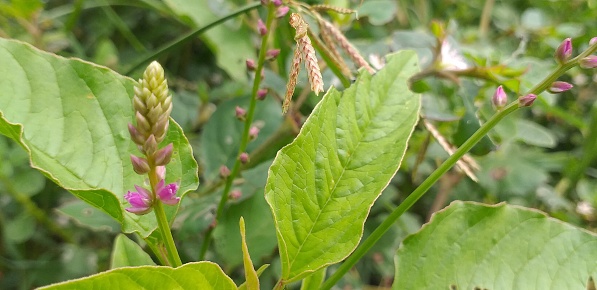

Digera muricata (L.) Mart.
|
It is commonly known as Latmahuria. It belongs to the Amaranthaceae family. Some of the bioactive compounds found in this plant are α-Spinasterol, β-Spinasterol and β-Carotene. The leaves are either eaten fresh in a salad or as cooked greens. Treatment of rats with Digera muricata extract (DME) significantly downregulated oxidative stress and protected the antioxidant enzymes of thyroid by enhancing levels of Catalase (CAT), Peroxidase (POD) and Superoxide dismutase(SOD). Mode of Consumption : Fresh in salad, fried and cooked |
| Plant Details | Agro-climatic Zone | Vernacular Names | Pictures |
| Scientific Name: Digera muricata (L.) Mart. Family: Amaranthaceae Juss. Class: Magnoliopsida Order: Caryophyllales Genus: Digera Forssk. Fruiting Season: Through out the year Parts: Leaves & stem |
|
Andhra Pradesh : Chenchulaku Bihar : Latmahuria, Lesua Delhi : Latmahuria, Lesua Haryana : Latmahuria, Lesua Jharkhand : Latmahuria, Lesua Karnataka : Chenchalisoppu, Goraji playa, Kankalisoppu Madhya Pradesh : Latmahuria, Lesua Maharashtra : Gitana, Getna Rajasthan : Latmahuria, Lesua Tamil Nadu : ToyaKeerai, KaatuKeerai Uttar Pradesh : Latmahuria, Lesua Uttarakhand : Latmahuria, Lesua West Bengal : LatamouriFul, Gun Gutiya |
 Plant |
| Compound/Extract | Activity | Mode of Action | Marker/References |
| Extract | Antioxidant | Treatment of rats with Digera muricata extract (DME) ameliorated the toxic effects of CCl4. Treatment of various doses of DME possibly inhibited the conversion of CCl4 into its reactive metabolites, decreased the oxidative stress and protected the antioxidant enzymes of thyroid as revealed by the enhanced level of Catalase (CAT), peroxidase (POD) and Superoxide dismutase(SOD). | CAT, POD, and SOD[1] |
| Major Class | Metabolites (Content of bioactives: mg/100g Fresh Weight) |
| Fatty acid ester | Octadecanoic acid, ethyl ester: [2] |
| Fatty alcohol | 1-Hexadecanol: [2] |
| Organochalcogen compound | Ethane 1,1-diethoxy: [2] |
| Phenol, 2-methoxy-4-4-(2-propenyl): , Cyclopentyltridecanoic acid, methyl ester: , 9-octadecanoioc acid, methyl ester: , Heptadecanoic acid, 9-methyl-methyl ester: [2] | |
| Amino acid | Thimine: [3] |
| Carotenoid | β-carotene: [3] |
| Fatty Acid | Cis-13-Eicosenoic acid: , Isopropyl myristate: , Hexadecanoic acid, methyl ester: [2] |
| Flavonol glycoside | Rutin: [3] |
| Heterocyclic Compound | Hyperoside: [4] |
| Organic compound | Cyclohexanol,1-(2-hexynyl): , Benzyl benzoate: [2] |
| Polycyclic aromatic hydrocarbon | Anthraquinone: [4] |
| Sterol | α-spinasterol: , β-spinasterol: , Stigmasterol: [4] |
| Vitamin | Ascorbic acid: [3] |
| Effect | Observation | DOI |
| Disease | Formulation | Reference | Author | TKDL |
| Information from Wealth of India | Reference |
|
CSIR(1952).The Wealth of India, Raw materials,Vol.-III ,P.59, New Delhi, India |
| 4.2, 4.2.1, 4.2.1.1, 4.2.1.3, 4.2.2.8, 4.2, 4.2.1, 4.2.1.1, 4.2.1.3, 4.2.2.8 |
| CSIR-North East Institute of Science and Technology, Jorhat-6, Assam, India
CSIR-Institute of Himalayan Bioresource Technology, Palampur-61,Himachal Pradesh, India |